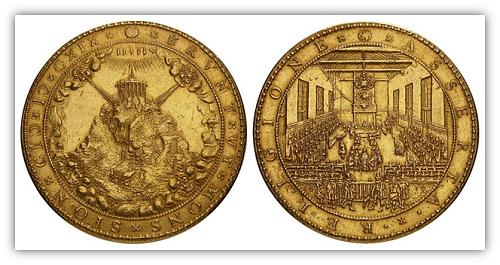Dort as the Source of Confessional Faith
Dort as the Source of Confessional Faith

THIS NOVEMBER WILL MARK THE 400TH anniversary of the first session of the Synod of Dort, convened November 13, 1618. Of course, the synod didn't close and promulgate its teachings until May 9th of 1619, presenting a conundrum for ecclesiastical anniversary celebrants around the globe: Do you celebrate Dort's anniversary this year or next?
This debate, I trust, won't rage nearly as long as the debate over Arminianism four centuries ago. Nor is it nearly as significant. But it is a fact that many Reformed Christians will be turning their attention to Dort over the course of the next year or so. This is a good opportunity for us to think a little more deeply about the Canons and the synod that produced them, and so I hope to occasionally write on this subject over the course of this year and next.
The Arminian Challenge to the Confessions⤒🔗
In one sense, Dort is the best known of the Three Forms of Unity. Far more people have heard of the "Five Points of Calvinism" than either the Heidelberg Catechism or the Belgic Confession. Few outside of Reformed churches today are aware of the 129 Questions about Calvinism or the 37 Articles on Calvinism. But in another sense — a real, historical sense — Dort is the least understood and the least familiar of our Three Forms. No doubt it is the least frequently read and least frequently taught.
This is ironic, because in an important sense, the Synod of Dort is the reason that the Heidelberg Catechism and the Belgic Confession enjoy the status they do in our churches today. And I think this is a good place for us to begin in considering the significance of the great national Synod, namely, as the source of our confessional faith.
Of course, Dort can take no credit for the existence of Heidelberg and Belgic per se. This is a matter of mere chronology. The Belgic Confession was written in 1561, by a persecuted church under the cross, and the Heidelberg Catechism was produced in 1563, commissioned by a prince, Frederick III, Elector of Palatine. The Synod of Dort was convened over 50 years later in the Netherlands.
But the existence of our Catechism and Confession in their present form and with their present authority is very much a result of the Synod that followed them. The two older forms had a certain status in the Dutch churches in the early years of their existence. We know, for instance, that pastors in Amsterdam at the time when Arminius was ordained in the 1580s would confess their support of the catechism. But the challenge of Arminius's teaching clearly presented a challenge to their authority and status in the churches.
The Remonstrants, the party who advocated for Arminius's views after his death, made a range of arguments which taken together would have weakened the role of the church's confessions if they had carried the day. They argued that the Confession and Catechism weren't clear on the questions raised by Arminius, and therefore shouldn't rule out its teaching in the churches. Some argued that the confessional standards were too clear, and should be revised in the light of the debated points. Ultimately, they held that the Arminian view was to be tolerated, and the confessional forms should only be retained in a spirit of tolerance that allowed theological diversity to flourish in the church.
The Material and Formal Principles of Dort←⤒🔗
The debate that led to the Synod was almost as much about the form the church should take — the authority that her confessional documents should exert — as it was about the particular doctrine in question. In this way it reflects the Reformation itself, which is often distilled to a debate about both a formal principle — Scripture alone! — and a material principle — Faith alone. The first principle was about how the church should arrive at doctrines and what authorities should govern its teaching. The second principle took up the most important what of those doctrines, namely, the church's teaching of salvation by grace alone through faith alone on account of Christ alone.
The Synod of Dort, like the Reformation, has a formal and material principle. As far as the subject matter, or material at hand, Dort is well-known for its teaching on grace and salvation. This is the essence of the "TULIP" acronym. But it is far less well-known for its teaching on the authority of the confessions, its formal principle.

Note that this teaching on the authority of the confessions is not an abandonment of the principle of Scripture Alone. Dort doesn't conclude that Scripture alone doesn't work; we need confessions alongside of Scripture. Rather, Dort confirms one of the core principles that undergirds Scripture Alone, namely, the clarity of Scripture. Scripture, Dort holds, is sufficiently clear on the key matters related to salvation, that the church should resoundingly affirm what it teaches.
Dort affirms, therefore, that church confessions are a necessary and healthy extension of the Scripture alone principle of the Reformation. In this sense, it is not a radical departure from the drafting of confessions that preceded it in both Lutheran and Reformed lands. In a sense, Dort plays a parallel function to the Lutheran Book of Concord, a collection of ten credal documents that established the bounds of orthodoxy for the Lutheran tradition. Indeed, this period of the drafting and adopting of confessional documents is often called by students of history, "the period of confessionalization."
Our Debt to Dort: the Form of Subscription←⤒🔗
The most tangible fruit of this work of Dort is the "Form of Subscription," adopted by the Synod and used to this day with few changes by Reformed churches around the world.
The Form of Subscription established the Three Forms of Unity as the doctrinal norm in the Reformed churches, and it is explicitly an expression of Scripture alone:
We, the undersigned, Ministers of the Gospel, Elders and Deacons ... sincerely and in good conscience before the Lord, declare by this our subscription that we heartily believe and are persuaded that all the articles and points of doctrine contained in the Belgic Confession and Heidelberg Catechism of the Reformed Churches, together with the explanation of some points of the aforesaid doctrine made by the National Synod of Dordrecht, 1618-'19, do fully agree with the Word of God.
Those who subscribe to the form promise not only that they believe these confessional documents agree with the Word of God, but that they will defend them, and contradict error. Further, if they find themselves "evolving" in their theology, departing from them in substance, that they will submit to the judgment of church authorities. If necessary, all ordained officers promise to step down from office if they depart from the teaching of the confessions.
Thus the synod took a stand for "the uniformity and purity of doctrine" in the church. They rejected the Remonstrant way of substantive theological diversity and tolerance within the church, and confessed the clarity of Scripture and the importance of the church articulating that doctrine. They also acknowledged the real inevitability of theological error in the church, and the importance of debate and discipline to keep the churches pure.
Had the Remonstrants won, we might well not have a Belgic Confession or Heidelberg Catechism today in their current form, a form that clearly teaches the doctrines of grace. Even if these forms hadn't been revised, they would most certainly not have the authority they enjoy, and they would play a less significant role in forming our faith and worship.

Furthermore, the impact of Dort was international. It may be a bit melodramatic, but we could even imagine an alternate history where the Westminster Standards, written in this same confessional tradition 25 years later, don't ultimately take the form or enjoy the status they do today.
Dort established the Reformed church as a confessional church. A church that clearly articulates, upholds, and defends the faith "once and for all" delivered to the saints. And that is something that we should celebrate in this, the year of its 400th anniversary.
Or next year.

Add new comment